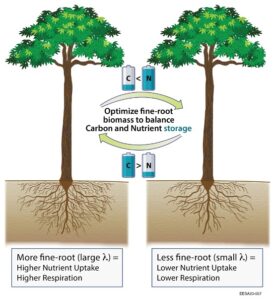Image courtesy of Knox et al. (2024). Illustration by Diana Swantek, Lawrence Berkeley National Laboratory. Visualization of the dynamic interaction between differential carbon (C) and nutrient (N) storage and fine-root growth. A plant (left) with proportionally more fine-root will tend to have decreased carbon allocation and increased nutrient allocation, than a plant (right) with proportionally less fine-root. The algorithm presented here seeks to balance these allocations through modifying fine-root growth. *Note that in this diagram, N is representing any nutrient, including nitrogen and phosphorus.
